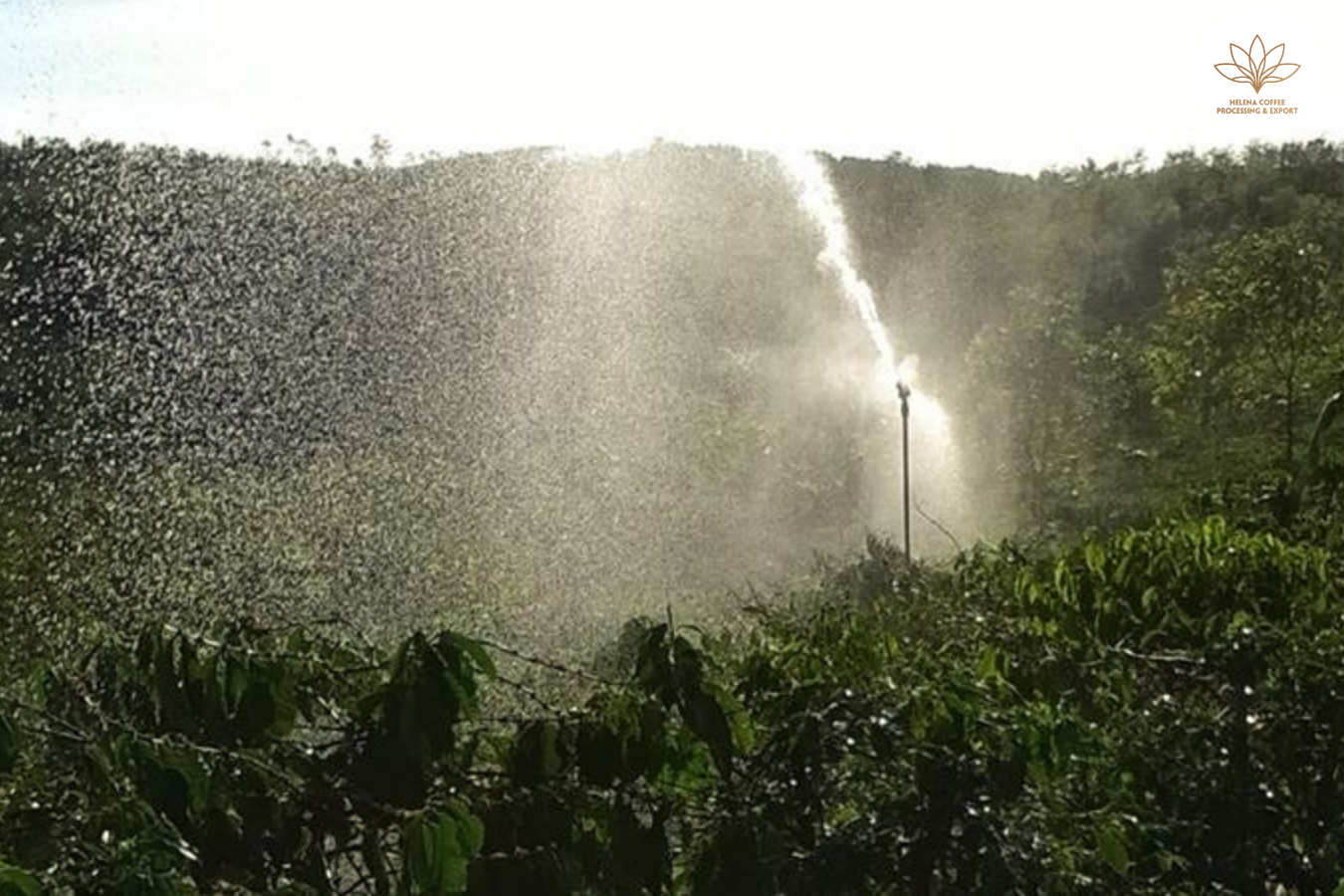
Watering techniques for coffee plants: In coffee growing areas where the dry season lasts more than 3-4 months, watering is decisive for coffee growth and productivity. Watering helps maintain the growth of the coffee tree, and is also a condition for the tree to flower. After a dry period to differentiate flower buds, plants that are watered enough will flower very concentratedly. The flowering stage requires a much larger amount of water than other stages because the respiration process is very strong at this time. At this stage, if there is a lack of water and high air temperature and low air humidity, the coffee flowers develop abnormally into star flowers and cannot be pollinated. There are also times when the flowers have sprouted beaks but lack of water and will turn into light purple lemon flowers and then dry up. Severe lack of water during this period can cause flower-bearing branches to dry and die.
1. Principles of watering
- Watering at the right time: If you water too late, the plant will become exhausted and lose its leaves and branches will dry out, but if you water too early when the plant has not yet fully differentiated the flower buds, the flowers will bloom haphazardly and unfocused, hindering the harvest. Besides, it also wastes investment costs for watering.
- Water enough: for flowers to bloom well, lack of watering will lead to lemon blossoms and dead branches.
2. Watering techniques
- Root irrigation: has the advantage of cheap equipment, low water loss, low fuel consumption, and low watering costs. Applying the root irrigation technique requires dredging and creating a basin around the root every year for convenient watering. This technique has the disadvantage of being labor-intensive and heavy to operate. This is the most commonly applied technique in coffee production in Vietnam.
- Sprinkler irrigation (sprinkler irrigation): has the advantage of creating cool microclimate conditions in the garden suitable to the physiological requirements of coffee trees, easy operation, and less labor-intensive. The drawback of this technique is that the equipment is expensive, water loss is quite large, especially for basic coffee plots and when there is high wind, high fuel consumption due to the need for pressurized nozzles. Strong enough to spray. Farms with large coffee areas often apply this technique. In some farming households, due to lack of labor, people have also used improved sprinkler irrigation techniques to suit the scale of farming households. A motor with a capacity of 15 horsepower can turn 2 rain trees and spray
for 5 hours, ensuring soil moisture for the area. However, farmers need to pay attention to watering in the tree areas. residual rain.
3. Quantify irrigation water and irrigation cycle
Depending on the climatic conditions of each region, determine the appropriate irrigation regime. Many coffee growing areas in our country have temperate climate conditions, the dry season does not last long and is harsh, requiring little irrigation or even no irrigation for a few years.
Many other regions, especially in the Central Highlands, often water 3-4 times during the dry season. The latest results on determining the amount of irrigation water for robusta coffee grown on basalt soil show that the most reasonable amount of irrigation water can ensure the growth of robusta coffee (planting grafted seedlings) during the period of basic construction and economic development. joint is:
- Year 2 KTCB: 240 liters/root, 22-24 days/time.
- Year 1 (new planting): 120 liters/root, cycle every 22 days.
- Year 3 (collection of 2.5 tons of kernels/ha): 320 liters/root, every 22-24 days.
- During the business period, 450-500 liters/root, every 25-30 days, especially for the first watering more: 600 liters/root.
Another irrigation experiment was carried out on commercial robusta coffee growing real plants grown in conditions with good wind-blocking forest belts. The coffee had an average yield of 3.5-4 tons of kernels/ha. The results showed that the amount of water from 390 – 520 liters/root with a cycle of 25-27 days/time depending on soil moisture can ensure the flowering and fruiting of coffee trees without significantly reducing productivity. significant compared to higher water volumes.
FAQS:
- Coffee Farming: Watering Techniques For Coffee Plants
- Techniques For Taking Care Of Coffee Gardens In The Last Months Of The Dry Season And The Beginning Of The Rainy Season
- Coffee Plant Care and Growing Techniques